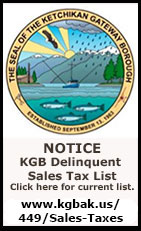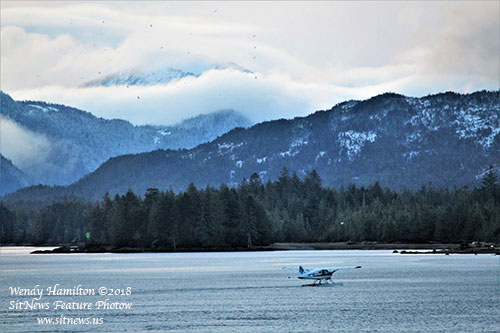






Weekly Specials
Online Shopping; Pickup or Delivery |
|













 Contact Contact 
 Webmail
Letters Webmail
Letters
 News Tips News Tips
 Copyright Info Copyright Info
 Archives Archives
Quick News
Search
 Alaska Alaska
 Ketchikan Ketchikan
 SE Alaska SE Alaska
Columns
- Articles
 Dave Kiffer Dave Kiffer
 Money Matters Money Matters
Historical
Ketchikan
 June Allen June Allen
 Dave
Kiffer Dave
Kiffer
 Louise
B. Harrington Louise
B. Harrington
Sports
 Ketchikan Links Ketchikan Links
Public Records
 FAA Accident Reports FAA Accident Reports
 NTSB
Accident Reports NTSB
Accident Reports
 Court Calendar Court Calendar
 Recent Filings & Case Dispositions Recent Filings & Case Dispositions
 Court Records Search Court Records Search
 Sex Offender Reg. Sex Offender Reg.
 Public Notices Public Notices
 Alaska Recall Alerts Alaska Recall Alerts
 Recalls.gov Recalls.gov
 AST Daily Dispatch AST Daily Dispatch
 KTN
Police Reports KTN
Police Reports
 Juneau Police Reports Juneau Police Reports
Weather,
Webcams
 Today's
Forecast Today's
Forecast
 KTN
Weather Data KTN
Weather Data
 AK
Weather Map AK
Weather Map
 AK Weathercams AK Weathercams
 AK Earthquakes AK Earthquakes

|
|

Thursday
December 27, 2018

|
Wolfe Point Sunrise
Front Page Feature Photo By WENDY HAMILTON ©2018
|
|
Fish Factor: Impact of Government Shutdown on Alaska Fisheries By LAINE WELCH - Hundreds of boats are gearing up for the January start of some of Alaska’s largest fisheries in waters managed by the federal government from three to 200 miles offshore.
Meanwhile, the federal government is in partial shut down following President Donald Trump's refusal to sign the appropriations legislation presented by Congress just before Christmas break. The White House withheld signing the legislation demanding that Congress approve $5 billion to be included for constructing a wall along the U.S. border with Mexico. Congress had included over $1 billion in the appropriations bill presented to the president for his signature. Thousands of federal workers have been furloughed with the partial shutdown amounting to about 25% or 800,000 of the federal government's workers.
Nine of the government’s 15 federal departments and several agencies were shuttered at midnight on December 21 and there is no end in sight. That includes the Commerce Department which houses NOAA Fisheries.
In an unusual first, no one at NOAA in Juneau could speak about the impacts a government shutdown might have on upcoming fisheries. All questions were referred “to the White House.”
An emailed response from the White House Office of Management and Budget said that, while “it can’t answer agency specific contingency questions,” as it stands now, Alaska’s big winter fisheries will get underway on schedule.
Fisheries management activities including quota monitoring, observer activities, and regulatory actions are considered “essential activities” that will remain during the shutdown.
Alaska’s cod fishery opens on January 1, followed by pollock and various whitefish on the 20th. No disruption is expected for those nor for ongoing crab fisheries.
The U.S. Coast Guard also will be at the ready for Alaska’s fishery openers. Nationwide, 42,000 Coast Guard will work without pay until a budget is passed.
Over the longer term, it’s disruptions to NOAA’s research that wreak the most havoc, said John Sackton at SeafoodNews.com.
Fish scientists involved in stock surveys and analyses, the foundation of Alaska’s fisheries, are furloughed due to Trump’s shutdown.
Gaps or lacks in data streams could halt catch allocations meted out over the year, or prompt more cautionary catches since the science would be lacking,
In Alaska, just over 100 fishery regulators are located in Juneau, 15 in Anchorage, one in Kodiak and two in Dutch Harbor. Another 100 or so are employed in fishery research labs in Seattle, Kodiak and Juneau. - More...
Thursday PM - December 27, 2018
Alaska: Alaska's Unemployment Rate at 6.2 Percent, Highest in Nation By MARY KAUFFMAN - November employment was down an estimated 0.4 percent, or 1,300 jobs, from November 2017. Off those job losses, 400 were government and 1,000 were in the private sector. Retail had the biggest loss at 700 jobs. Professional and business services and manufacturing each lost 500 jobs over the year. Financial activities lost 300 jobs over the year. Of the 400 government job losses, 300 were local government job losses and 100 were federal job losses. Information services lost 100 jobs.
The national unemployment seasonally adjusted rate remains at 3.7 percent through November 2018. The U.S. Bureau of Labor Statistics reports Alaska has the highest unemployment rate in the nation at 6.3 percent.
Statewide, health care added the largest number of jobs over the year at 500, employing 38.100 as of November 2018. The transportation, warehousing and utilities industry added 300 and construction gained 200.
The Alaska state government added 100 jobs during 2018, with 23,900 state jobs as of November 2018. However, federal jobs were down 100 and local government jobs were down 300.
Overall, private sector job numbers were down 0.4 percent and government jobs were down by the same percentage if federal job losses are not considered. The state has 23,900 jobs, the federal government has 14,500 jobs and local government statewide reports 42,800 jobs as of November 2018.
Alaska’s seasonally adjusted November unemployment rate was 6.3 percent, down one-tenth of a percentage point from October, and the comparable national rate was 3.7 percent. - More...
Thursday PM - December 27, 2018
|
|
Alaska: Oyster farmers face challenges and opportunities in Alaska By PAULA DOBBYN - Mariculture is an emerging industry in Alaska that Alaska Sea Grant is helping to promote. Recently some of the Alaska Sea Grant faculty and staff gathered in Cordova with shellfish farmers, oyster spat growers and a kelp farmer to share ideas and strategies. It was part of the Alaska Shellfish Growers Association’s annual conference.
Experts on marketing and business resources, including staff from federal and state agencies, researchers, and Alaska Sea Grant’s Quentin Fong and Torie Baker,, were among the attendees.
“We heard just how hard it is to be a shellfish grower in Alaska, and we discussed ways to ease that burden,” said Heather Brandon, director of Alaska Sea Grant. “I was particularly struck by Jim Aguiar’s story.”
Aguiar of Eagle Shellfish Farms, located in Prince William Sound, has tested and improved on five iterations of oyster cages, the gear used to grow oysters in the sea. He began with plastic cages, but sea otters easily chewed holes in the sides, reached their arms in, plucked out all the oysters and ate them, Brandon said.
The next season Aguiar switched to metal, but the racks inside the cages rusted, became worn through from chafing, or collected biofouling—creatures that attach to both gear and oysters, and limit oyster growth.
“Finally, after 15 years and feeding over 1 million oysters to sea otters and sea stars, Jim has dialed in his gear and his techniques, using coated metal racks and dipping the cages in 140-degree water, called ‘hot dipping,’ once during the growing season to kill the biofouling,” said Brandon. - More...
Thursday PM - December 27, 2018
Alaska: Doug Vincent-Lang Appoints Three to Key Leadership Roles at the ADF&G - Acting Alaska Department of Fish & Game (ADF&G) Commissioner Douglas Vincent-Lang recently announced three key staff appointments.
Vincent-Lang has appointed Benjamin J. Mulligan Deputy Commissioner effective Jan. 3, 2019. Also appointed are Edward K. Grasser Director of the Division of Wildlife Conservation effective Dec. 26 and Rick Green Special Assistant to the Commissioner began work Dec. 17.
"These are talented individuals who will play integral roles as the department renews its focus on putting food on the plates of Alaskans, protecting and maintaining the state's management authority, building dialogue and trust, and ensuring that the department is contributing to the economy and well-being of our citizens," said Vincent-Lang.
As deputy commissioner, Mulligan will be responsible for overseeing statewide fisheries and wildlife regulatory and management issues. He will also act as chief of staff to the commissioner.
Mulligan brings to his new role a long, successful history in the business community, working closely with lawmakers and on fisheries-related issues. He acted as special assistant and legislative liaison for ADF&G from 2010 to 2015 before joining the Alaska State Chamber of Commerce where he currently serves as vice-president. Prior to his five years at the department, he worked for Rep. Bill Stoltze in a variety of positions including chief of staff. He earned his B.S. in biology with a fisheries emphasis from the University of Wyoming.
"I have appreciated the complexity and importance of fish and wildlife issues in Alaska since I started work at my first fisheries technician job in Bristol Bay," said Mulligan. "The department is full of Alaskans who love their jobs and the resource they help manage. I look forward to working on those issues with them once again on behalf of the commissioner and all Alaskans." - More...
Thursday PM - December 27, 2018
|
Analysis: In 2019, women's rights are still not explicitly recognized in US Constitution By DEANA ROHLINGER - Over nine decades, efforts to amend the U.S. Constitution to recognize women’s rights have faced major challenges.
Congress finally passed such legislation, known as the Equal Rights Amendment, in 1972. The amendment would recognize women’s equal rights to men under the law.
Despite concerted campaigns by women’s rights groups, it fell short of the 38 states that needed to ratify it in order for it to become part of the Constitution. The original deadline for states to ratify was 1979. Congress extended the deadline to 1982, but even then it still fell three states short of passage.
Nevertheless, women’s rights activists have continued working to get states to ratify it.
Many ERA proponents argue that the deadline is irrelevant because the 27th Amendment to the Constitution, which prohibits changes to the salaries of congressional legislators, was ratified in 1992, 203 years after it was introduced. The same could happen to the ERA, they argue. They maintain that Congress has the power to change the deadline and recognize the 38 ratification votes to approve the amendment.
Some constitutional experts, however, argue that it may be too late, since the deadline passed more than three decades ago. They also suggest that, while its passage would have symbolic importance, the ERA might only make a difference at the margins where the law still allows sex discrimination.
I’m a scholar who studies gender and politics. Here’s a quick summary of how the country got to this point and the barriers that still exist to adding the Equal Rights Amendment to the Constitution.
‘Ladies against women’
Women’s rights advocates argue that sex discrimination is a pervasive problem that could be resolved by the ERA. Even though the Equal Protection Clause in the 14th Amendment prohibits states from denying any person equal protection under the law, women’s rights are not explicitly guaranteed.
The push for equal rights heated up in the 1920s after women gained the right to vote. Alice Paul, a suffragette, proposed the first version of an Equal Rights Amendment in 1923. The proposal was adopted and turned into proposed legislation by two Kansas Republicans, Sen. Charles Curtis and Rep. Daniel Anthony Jr., and was brought up during every congressional session between 1923 and 1971 without success.
The idea of an Equal Rights Amendment, however, gained momentum among politicians and the broader public. World War II opened many doors for women, who filled gaps in the labor force while men were off fighting. During this time, women were welcomed into politics, onto juries, openly wooed by educational institutions and encouraged to take up male-dominated majors such as math, science and technology.
By 1970, the Equal Rights Amendment had been endorsed by four sitting presidents – Republicans Dwight D. Eisenhower and Richard Nixon, and Democrats John F. Kennedy and Lyndon Johnson. The fledgling feminist group, the National Organization for Women, adopted the passage of the ERA in its 1967 Bill of Rights for Women and began staging massive demonstrations and lobbying politicians in the late 1960s and early 1970s in an effort to get Congress to pass the amendment.
Finally, in 1972, the ERA passed both houses of Congress. The Amendment would have seven years to be ratified by three-fourths, or 38, of the 50 states.
While 30 states ratified the ERA in 1972 and 1973, the amendment ultimately came up three states short of approval by the 1979 deadline. - More...
Thursday PM - December 27, 2018
|
 |
MICHAEL SHANNON: Bipartisanship Is Another Word for Ignoring the Base - Here's how the Opposition Media's beloved "bipartisan cooperation" works among the residents of Incumbentstan here in Washington, DC. Republicans join leftists to proudly pass a "prison reform" bill that is of absolutely no importance to the conservative base that keeps Washington country club conservatives in offices.
But all passage of "prison reform" really proves is Curator of the Senate Mitch McConnell and retiring Boy Ryan are more than willing to quickly pass a bill that speeds the process of putting illegal immigrants in prison back out on the street. Unfortunately, they won't spend a dime to prevent illegal immigrants currently out of the country from finding a way back in.
In fact, McConnell is having trouble keeping is utter disdain for the base that elects him in check. His latest disingenuous move is a continuing spending resolution that pushes wall funding into February when Nancy Pelosi will be running the House.
Building the wall, deporting illegals and citizen-first immigration reform were the issues that elected President Trump. That should have been the primary focus of his administration from the beginning.
Trump did face a unique situation. First, he didn't expect to win, which is something he and Hillary had in common. He had to scramble to staff his administration. It was chaos. The only difference between the product of Trump's HR department and Uber's was Trumps staffers didn't assault women. Oh, wait. Well at least not as many as Uber drivers.
He was closest advisors were Democrats, daughter Ivanka and son-in-law Jared. Neither of whom would have voted for any other Republican candidate running on Dad's issues. Staff slots went to closet Never-Trumpers who opposed his immigration plans and careerists dragging their feet because they were afraid Trump's policies would kill future job prospects with housebroken conservatives and big donors after they left the administration. - More...
Thursday PM - December 27, 2018
|

Political Cartoon: Shutdown Rumble
By Bruce Plante ©2018, Tulsa World
Distributed to paid subscribers for publication by Cagle Cartoons, Inc.
Abolish Salmon Hatcheries? By
Jay Leo Baldwin - Orcas are starving due to the lack of chinook salmon and other marine life. Cultivating salmon eggs was thought to be the answer to the dwindling salmon stocks. As early as the late 1800’s the Federal Fisheries Act required fish companies to produce four times the number of salmon fry as were taken of the mature salmon for the season. Now after more than 100 years of salmon hatcheries the numbers of salmon returning continues to dwindle so much so that user groups are fighting over the last few fish.
Groups are pressuring the state not to close the fishery, and NOAA is asking the State for ways and means of increasing the availability of chinook salmon for Orcas that are starving,. Seals and sea lions are being found dead on the beach from a bullet probably by fisherman who think seals eat too many salmon. Seals are Orca food, too.
We need a more eco-friendly system of raising salmon that more closely duplicates the natural cycle of salmon. Small remote hatchery sites, using gravel incubating systems from which hatched alevin could migrate into the gravel shoal naturally would be far better, much cheaper, too.
New hatching techniques can be studied, that use far less water , during cold weather. Remote sites can even be labor free, and automated. Techy times are here.
Why is that better? Migrations would be more natural, at the tiny, fry stage. The result of pond rearing over a hundred year period has over fed the predators with tamed, large, pond fed juveniles salmon, not wild fry. Large, stupid juveniles are slaughtered by predators; take a look at squaw fish, now classified a minnow called Northern Pike, It almost exclusively and voraciously feeds on salmon juveniles released from hatcheries and has become so established in the Columbia River that bounties are paid to catch them. In the Sacramento River the hatcheries truck their juveniles to the ocean to escape the slaughter by squaw fish. Now pike can weigh several pounds, and are particularly available in the large rivers with dams. Timing means everything for juveniles and adults, both. getting past the dams is one problem, on the way out, and then getting back upstream upon return is the other. Hydropower dalms need to be abandoned and get a crash program going for solar. We need another ‘New Deal’ for putting people to work building solar colonies to replace dams.
Rivers have always had lakes, and some species hold over a year making their way downstream at the right time: chinook, sockeye and coho. Chum and pink salmon, however, usually spawn streams at lower elevations. Dams are getting old and are a danger to all.
When spring comes the long sun days bring everything to life.
The ocean blooms the same way. Juvenile salmon migrate to salt water at bloom time, but only at night for better survival. On the dark of the moon, before the spring equinox during the month of March, they make a dash for it, hiding during the daylight hours.
And in April, during the dark moon, fry from the northern regions migrate, hiding during the day and .making their dash for the ocean at night. Some go down steam head first, some tail first. Nature is fantastically smart, and is the true university. We just need to study it more carefully and try not to disturb it, or as little as possible, and try to integrate into its rhythms. Hatcheries claimed to be an improvement on nature: Wow! What a political ego trip that is.
Hatcheries put a bunch of eggs in a pail of water, introduce milt, male sperm fluid, mix it up and try to get it into trays, in the dark and motionless in a very few minutes, as they become very fragile. Light is lethal to fertilized eggs. That whole process has mongrelized the species, since nature is far different than hatching and pond rearing. Actually, mixing eggs from several females in a bucket, has reduced the size of hatchery fish by half, depriving the spawn of fertilization by the large, dominant male. Therefore, half the tonnage is missing from the ocean. No wonder Orcas are hungry. - More...
Thursday PM - December 27, 2018
 Webmail your letter or Webmail your letter or
 Email Your Letter To: editor@sitnews.us Email Your Letter To: editor@sitnews.us
|
Articles &
photographs that appear in SitNews may be protected by copyright
and may not be reprinted or redistributed without written permission
from and payment of required fees to the proper sources.
E-mail your news &
photos to editor@sitnews.us
Photographers choosing to submit photographs for publication to SitNews are in doing so, granting their permission for publication and for archiving. SitNews does not sell photographs. All requests for purchasing a photograph will be emailed to the photographer.
|
|

















The Local Paper is
available online.
Click here for this week's printed edition (PDF)

|
|


![]() Contact
Contact ![]()
![]() Webmail
Letters
Webmail
Letters![]()
![]() News Tips
News Tips![]()
![]() Copyright Info
Copyright Info![]() Archives
Archives![]() Alaska
Alaska![]() Ketchikan
Ketchikan![]() SE Alaska
SE Alaska![]() Dave Kiffer
Dave Kiffer![]() Money Matters
Money Matters ![]() June Allen
June Allen![]() Dave
Kiffer
Dave
Kiffer![]() Louise
B. Harrington
Louise
B. Harrington ![]() Ketchikan Links
Ketchikan Links![]() FAA Accident Reports
FAA Accident Reports ![]() NTSB
Accident Reports
NTSB
Accident Reports![]() Court Calendar
Court Calendar![]() Recent Filings & Case Dispositions
Recent Filings & Case Dispositions ![]() Court Records Search
Court Records Search![]() Sex Offender Reg.
Sex Offender Reg.![]() Public Notices
Public Notices![]() Alaska Recall Alerts
Alaska Recall Alerts![]() Recalls.gov
Recalls.gov![]() AST Daily Dispatch
AST Daily Dispatch![]() KTN
Police Reports
KTN
Police Reports![]() Juneau Police Reports
Juneau Police Reports ![]() Today's
Forecast
Today's
Forecast![]() KTN
Weather Data
KTN
Weather Data![]() AK
Weather Map
AK
Weather Map![]() AK Weathercams
AK Weathercams![]() AK Earthquakes
AK Earthquakes







































